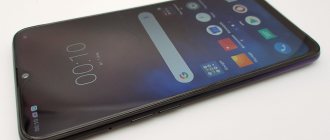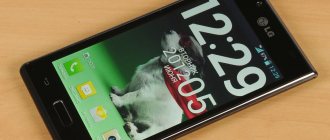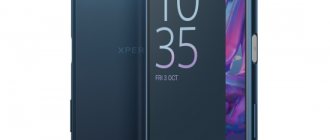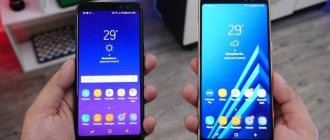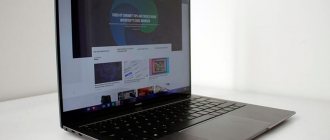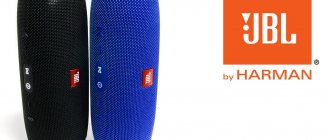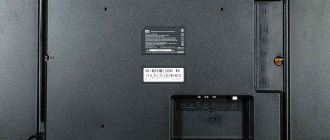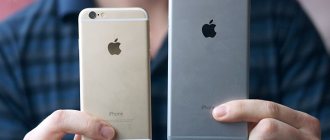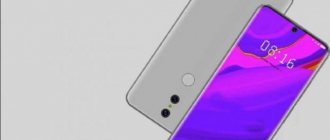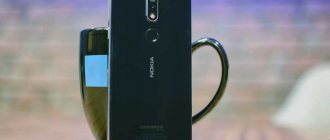Content
- Introduction From flagship to best-selling model
- The manufacturer himself decided who needs what
- Battery capacity increased
- Display Specifications
- Multi-window mode
- Main cameras
- Wireless charging mode
Move over flagships, a future bestseller is appearing on the scene! With the G6, LG wasn't trying to take the lead in the tech race. Instead, they tried to reach a very wide range of consumers and create something that would be significantly different from the V models in the company's products. This is how the high-end G6 was born, with some very notable features.
LG G6 Photo Quality: Street Lighting
In bright daylight conditions, the LG G6 produces well-balanced images. They are quite bright, detailed, the colors are natural, vibrant, but not oversaturated. White balance is correct. In rare cases, there is a change in the white balance towards blue or green shades, due to this, the pictures turn out cold and require “warm” filters.
HDR also doesn't always work correctly, which is especially noticeable when shooting brightly lit objects and high-contrast scenes. In HDR mode, highlights appear around contrasting objects.
Where the LG G6's camera excels is in capturing detail and surface textures in high-contrast areas of photos, while detailing in low-contrast objects is noticeably reduced.
Autofocus works quickly and locks onto specified objects clearly.
Specifications LG G6
- Housing: Aluminum frame, Gorilla Glass 3 on the screen and Gorilla Glass 5 on the back, LCD touch panel with rounded edges for added durability, IP68 water and dust resistance
- Screen: 5.7″ diagonal, resolution 2880 x 1440 pixels with a density of 565 ppi, aspect ratio 18:9, support for HDR 10 and Dolby Vision technologies, maximum brightness 500 nits (in direct sunlight - 600 nits)
- Main camera: two modules - 13 megapixels with f1/8 aperture and 71° viewing angle with optical image stabilization; 13 MP with f/2.4 aperture with a range of 125° without stabilization; Video quality 2160p at 30 frames per second
- Front camera: 5 MP with a range of 100°; 1080p video quality at 30 frames per second
- Operating system: Android 7.0 Nougat; full screen display in 2:1 format
- Chipset: Qualcomm Snapdragon 821; Quad-core processor (2 Kryo cores @ 2.35 GHz + 2 Kryo cores @ 1.6 GHz), Adreno 530 GPU
- Memory: 4 GB RAM, 32 GB/64 GB internal memory (depending on region), micro SD memory card slot up to 2 TB
- Battery: 3300 mAh lithium polymer (non-removable), supports QQC 3.0 fast charging technology, WPC and PMA wireless charging (US versions only)
- Network connectivity: 1 SIM card (2 SIM cards for Asian countries), LTE-A mobile standard, support for 3 Cat. 12 and Cat. 13 (600/150 Mbps), USB Type-C connector, support for Wi-Fi a/b/g/n/ac, GPS, Bluetooth 4.2 technologies; FM radio (except South Korea, USA and Canada)
- Additional features: fingerprint scanner, digital-to-analog audio converter Hi-Fi Quad DAC (North Korea only), 2 microphones, speaker at the bottom of the case, 3.5 mm jack
Regardless of the geographic location of sale, a camera of two modules is built into the back panel of all G6 smartphones: one with a range of 125° without stabilization, the other with a viewing angle of 71° with optical image stabilization. Reminiscent of the G5 and the previous V20, but not exactly the same: the G6 takes pictures with a resolution of 13 megapixels in a 4:3 format instead of the 16 megapixels + 8 megapixels in a 16:9 format of its predecessors. Both modules have a slightly smaller viewing angle. For selfies, there is a 5 MP front camera, which, due to the features of the body, has a shooting range of 100°.
Battery capacity increased
The battery capacity has increased by 18% compared to the G5. Now this value is 3300 mAh, which is definitely pleasing. This time it's built-in, meaning you won't have the opportunity to insert another charged battery to replace the one that has reached 0%. Modular design is a thing of the past with the G5, apparently it was not the best functional solution, since sales did not meet the creators' expectations. That's why the new product received an all-metal body.
Autonomy
The battery built into the LG G6 has a capacity of 3300 mAh. Unfortunately, the PCMark battery life test gave an error on the smartphone, so all three attempts to run it ended in failure. In everyday use, the smartphone provides more than a day of battery life with more than 6 hours of active screen.
This includes background synchronization, the use of instant messengers, social network clients, 30 minutes of calls per day, an hour in games and YouTube, and an hour of listening to music. That is, you can actively use your smartphone all day and not worry that it won’t survive until the evening. This is a good result for a battery of this capacity. In addition, the LG G6 supports Qualcomm Quick Charge 3.0 fast charging and charges via the USB Type-C port.
5
ITC.UA rating
Pros: design, materials, build quality, IP68 and MIL-STD 810G protection, display, performance, cameras, built-in 32-bit D/A converter, battery life, fast charging
Cons: easily soiled case, high price
Conclusion: LG G6 is a new flagship smartphone with a 5.7-inch display that occupies almost the entire front panel. This design originates from the LG G2, one of the company's most successful smartphones. Considering this fact, as well as a generally good set of characteristics, we can say that after a number of not the most successful smartphones, LG managed to create a truly interesting product. And even though this year the competition among flagships is higher than ever, the LG G6 has something to stand out from them. The strengths of the model include a large display in a relatively compact case, two cameras with good image quality, a built-in DAC, and case protection according to IP68 and MIL-STD 810G standards. The LG G6 has practically no downsides, and the only serious one for Ukrainian consumers will be the high price of the smartphone, which is generally typical for flagships from A-brands
Specifications
| LG G6 64GB Platinum (LGH870DS.ACISPL) 5,449 − 5,449 UAH Compare prices | |
| Type | Smartphone |
| Pre-installed OS | Android 7.0 |
| RAM, GB | 4 |
| Built-in memory, GB | 64 |
| Expansion slot | + |
| SIM card type | Nano-SIM |
| Number of SIM cards | 2 or 1 + memory card |
| CPU | Qualcomm MSM8996 Snapdragon 821 + GPU Adreno 530 |
| Number of Cores | 4 |
| Frequency, GHz | 2,35 |
| Battery | Li-Ion, 3300 mAh (non-removable) |
| Diagonal, inches | 5,7 |
| Permission | 2880×1440 |
| Matrix type | IPS |
| PPI | 564 |
| Dimming sensor | + |
| Display Features | HDR support |
| Main camera, MP | 13 (f/1.8, OIS, 3-axis) + 13 (f/2.4) |
| Video shooting | + (4K) |
| Flash | + |
| Front camera, MP | 5 (f/2.2) |
| Communication standards | GSM 850 / 900 / 1800 / 1900, HSDPA 850 / 900 / 1900 / 2100, HSPA 42.2/5.76 Mbps, LTE-A (3CA) Cat12 |
| WiFi | 802.11ac |
| Bluetooth | 4.2 (aptX) |
| GPS | + |
| IrDA | — |
| FM radio | + |
| Audio jack | + |
| NFC | + |
| Interface connector | USB Type-C |
| Height, mm | 148,9 |
| Width, mm | 71,9 |
| Thickness, mm | 7,9 |
| Weight, g | 163 |
| Protection from dust and moisture | IP68 |
| Type of shell | monoblock (non-separable) |
| Housing material | metal/glass |
| Keyboard type | screen input |
| More | fingerprint scanner |
Display and device
Apparently, when developing the new design, the engineers were tasked with pleasing the modern user - the screen should be as large as possible, but control should be comfortable with one hand.
Display Specifications
The fact that the new expanded display is housed in a body with the same dimensions as in the G5 can only mean one thing - the monitor has acquired an elongated shape. The new smartphone is equipped with a 5.7″ diagonal screen with a resolution of 2880 x 1440 pixels and a density of 565 ppi (this figure is higher than that of the G5). It also features a revolutionary 18:9 aspect ratio and curved edges.
The manufacturer assures that the maximum brightness of the G6 is 500 nits, and the automatic settings switch allows you to increase this value to 600 nits in direct sunlight. Well, at least on a bright sunny day the new flagship displays a better picture than the previous G5.
The G6's display supports HDR 10 and Dolby Vision video technology, which is undoubtedly great. There is only one BUT: only 15 films and 11 TV series were shot in the Dolby Vision format (together on the Netflix and Amazon websites). The selection of HDR 10-quality videos is slightly larger. We can only be glad that if the situation improves, G6 owners will be fully prepared to watch high-quality videos.
Design Features
The corners of the screen are rounded, and this is no coincidence. Being an extraordinary design find, they also give the glass additional strength in case of strong physical impact. This is extremely important for the new product from LG, since the edges of the display are located as close as possible to the overall edges of the phone body.
The company's employees conducted numerous experiments, the results of which proved that almost half of the falls of smartphones occur on their side ribs. In this case, ordinary corners are subjected to excessive compression and pressure, which inevitably leads to damage and malfunction of internal systems. Rounded edges distribute the received energy better and are therefore more resistant to breakage. Be that as it may, remember that the G6 does not belong to the category of “indestructible” smartphones, so it is better not to test its durability.
Display coating
The display is covered with scratch-resistant Gorilla Glass 3. The creators gave preference to the third generation because, in their opinion, it is not as thick as subsequent modifications. But nothing prevented them from installing Gorilla Glass 5 on the back panel. By the way, the manufacturer claims that fingerprints do not remain on it, but glass is glass, so sometimes it gets noticeably dirty. However, this is not so critical and is less noticeable on white and gray smartphones than on a black model.
The manufacturer also proudly emphasizes that the camera design has changed - now it does not protrude above the surface of the phone, as it did in the G5. (It must be admitted that this element was not the most attractive in the overall design, if not worse.) The new appearance has become much more pleasing to the eye.
Fingerprint scanner
The fingerprint scanner is located at a very advantageous point on the body, in close proximity to the fingers, when the phone lies comfortably in the palm of your hand. Perhaps LG took into account the gossip that arose after the Galaxy S8 went on sale, because many claimed that the scanner was carried away somewhere to the camera, and in order to reach it you need to have incredibly long fingers. Be that as it may, the G6 model intelligently takes this feature into account.
Housing and its components
The front and rear glass are held firmly in place by an aluminum frame that is also well thought out. Plastic inserts for connectors and keys are moved away from the edges of the case in order to minimize the load and prevent the appearance of cracks, where water can easily leak.
By the way, LG G6 is rated IP68 for protection against water and dust. This is the second smartphone in the company's history (after the waterproof Optimus GJ) that prevents the penetration of external solid and liquid particles. Moreover, the manufacturer guarantees resistance not only to fresh water, but also to sea water. Perhaps for some this characteristic will be very useful.
Display
The LG G6 has a 5.7-inch IPS display with a resolution of 2880x1440 pixels (564 ppi) and an aspect ratio of 18:9. Traditionally for LG, the screen displays high-quality images with wide viewing angles.
According to our measurements, the maximum display brightness reaches 422 cd/m2, the minimum is 3.3 cd/m2, and the contrast is 1681:1.
The screen provides more than 100% coverage of the sRGB color space, but by default its color rendering is quite “cool”, it is at 7450K, but this can be corrected by activating the “blue light filter”. The latter has three gradation modes, as well as the ability to switch the display to black and white mode.
The LG G6 display supports HDR 10 technology, which makes the image in video more saturated, but this only works in Netflix and Amazon Prime Video applications.
Non-standard aspect ratio does not affect the display of Android applications, at least not current ones. They can be scaled to a 16.7:9 aspect ratio, in which case the navigation keys and status bar are displayed, or to a full 18:9 screen.
The latter is relevant for games, but not all of them adjust correctly to this aspect ratio, so more often you have to run them with black bars on the sides of the screen. The same applies to watching videos. However, you quickly get used to this feature of the smartphone.
The LG G6 also has a feature to show information on the locked display.
This can be time, notification icons, or arbitrary text.
Software and benchmark results
So, the smartphone has an impressive display, what can you do with it now? Its aspect ratio is 18:9 or 2:1, which visually looks like two equal 1:1 squares.
LG plays with this idea in every possible way and creates Full-screen UX - a full-screen mode developed based on the user's impressions of working with a mobile interface. For example, in most branded applications information is logically displayed in 50/50 groups. For example, in the player, the information and album art are in the top half, while the control panel is in the bottom half of the screen. The squares are separated by a progress indicator in an accessible and unobtrusive manner.
The incoming call page is divided in the same way, where the subscriber’s photo and data are located at the top, and the answer and call reset buttons are located at the bottom.
Other apps don't have the same obvious redesign to accommodate the unusual screen structure. However, the elongated display still gets the job done. For example, when opening the messenger, you can see more text on one page, therefore, you have to scroll less, which can save you time (this is especially noticeable when working with the keyboard, which, as a rule, covers a good half of the screen). The G6 runs on the latest version of Android Nougat, which isn't surprising since the V20 was the first smartphone on sale running Android 7.0 and it's been a few months since then.
Multi-window mode
This modification has certain advantages, but in this case one specific detail deserves special attention - this is the multi-window mode. The elongated screen provides significantly more space for two applications, which makes working with them a pleasure. Not to mention, it's a valuable productivity boon.
As mentioned above, the LG G6's display has curved edges to make the screen more durable. However, manufacturers have gone further and transferred this feature into software. The borders of the labels are also slightly beveled, “turned in” and follow the contours of the case.
Third party app shortcuts
Shortcuts for third-party applications that have specific shapes are placed against the background of the same squares, so that they all have the same size. (Think of the G5, whose menus made YouTube or Hangouts look tiny compared to the built-in programs.)
And yet, there is one delicate nuance in equipping a smartphone with an 18:9 screen. How will 16:9 apps optimize their UI and content? Company representatives respond that they will be shown in their original form. In particular, a video designed for this format will be played in a cropped form, that is, with black bars on the left and right.
Apps typically have 16.7:9 space reserved, with 1.3:9 at the bottom reserved for navigation buttons. For an elongated screen, the transformation is simple - the application takes up 16:9 space, leaving the remaining 2:9 for the control panel.
Benchmark statistics
The LG G6 is powered by the Snapdragon 821 chipset, which is still Qualcomm's leading chipset, although that may change in the coming months with the release of the S835-equipped Galaxy S8. Now the S821 is inside the most powerful smartphones from Google's Pixel and OnePlus 3T, as well as a couple of Xiaomi models.
The results obtained after testing the G6 confirm and even in some ways exceed the expectations and declared capabilities of the S821, which, however, it had already demonstrated earlier on other devices. Thus, screen tests showed the presence of 2,672 x 1,440 pixels instead of the announced 2,560 x 1,440 pixels, although this has practically no effect on the image. Of course, all the data obtained should be taken with a discount for the fact that the device is not equipped with the latest version of the software.
GeekBench 4 (multi-core)
GeekBench 4 (single-core)
AnTuTu 6
Basemark X
Performance
"Trash" for applications
The new LG G6 has the ability to move applications that are not very necessary to a special directory. The essence of this directory is almost the same as the “Trash” on a computer, where you can put files that you no longer need or don’t want to use at all. In this case, you remove applications that you do not want to use. They will remain in the above directory for 24 hours (just in case you change your mind) before being completely deleted.
Camera
For the first time, LG experimented with introducing a dual-module camera on the V10 model, which caused positive reviews. That's why the idea of combining a regular lens and a wide field of view lens was taken to the next level with the G5. However, there the duo of 16 MP and 8 MP had too much volume, after which something new appeared in the G6.
Both modules are connected to different lenses using absolutely identical 13 MP Sony IMX258 sensors.
Main cameras
The “regular” lens (which still has a fairly wide field of view of 71°) has an f/1.8 aperture, while the second one provides an extended 125° range with an f/2.4 aperture. With identical sensors, it would be easy to confuse the role of the modules and determine which of them is the main one. However, there is a very significant difference between them. The main lens has optical image stabilization and autofocus functions, while the other one does not.
It is necessary to clarify right away - the G6 camera does not provide the ability to create any photo tricks like the bokeh effect or flash fill. The company's engineers tried to master this direction, however, in the end, it was decided to develop one parameter in detail and consistently, and it became the viewing angle range.
Front-camera
The 5 MP front camera takes pictures from angles up to 100°. From one sensor you can take pictures in both regular and extended format.
Camera app
The camera application has been updated to make it convenient for the user to work in 18:9 format. With 4:3 sensors, the viewfinder only shows 2/3 of the screen, and even the settings window doesn't fill the entire display. That's why the developers came up with the following move: the rest of the monitor is designed in the form of a photographic film, whose frames represent the last pictures taken. Very original, but you always need to remember this when giving the phone into the hands of other people with a request to capture the moment.
Continuing the theme of two squares, LG offers the user a whole variety of shooting modes that are most successfully combined with a similar screen aspect ratio and are absolutely inapplicable to the 16:9 format (and others too).
The electronic assistant automatically superimposes the image taken earlier onto the scene available to the viewfinder (you can adjust the transparency “to suit you”). This way you can get your own photo based on the one someone else took before you. Grid mode allows you to split the screen into a 2x2 table that shows you an overview of the photos you took in succession. During this time, shooting can continue at the top of the screen. And finally, the “Merge” mode provides the ability to create fantastic collages by combining two completely different pictures.
Sample photos of LG G6: Regular camera
Sample photos of LG G6: Wide-angle camera
Sample video LG G6 4K 2160p 30fps
Brief summary
(for those who are too lazy to read further)
The LG G6 creates high-quality images with good exposure, correct color rendition and white balance, and high detail. Autofocus works quite quickly. However, you can only get photos of this quality in bright daylight conditions. When the lighting changes, noise appears in the photo, contrast and detail decrease, which is why the smartphone receives such a low rating.
The video camera receives 83 points out of 100 possible. The assessment is explained by changes in the quality of the video footage under different lighting conditions. In bright daylight, the smartphone shoots video in a wide dynamic range, with high detail and excellent white balance. In poor lighting conditions, a video camera suffers from the same problems as a photo camera: noise appears, detail and contrast decrease.
The LG G6's camera scores are well deserved.
What else is interesting
The G6 is equipped with a 3300 mAh battery, which is 18% more than the G5. This seems like a significant upgrade, but in reality only 8% of it is dedicated to the monitor's performance. The G6 supports Qualcomm QuickCharge 3.0 fast charging technology, which allows the smartphone to get from 0% to 50% energy in 32 minutes, and up to 100% in 96 minutes. In addition, a special analyzer, based on the total battery life and temperature indicators, sets optimal parameters in real time to extend the life and service life of the battery.
Wireless charging mode
In versions intended for the USA, wireless charging mode (WPC and PMA) will be available. In this strange way, LG decided to compete with Samsung Galaxy, which has supported this technology for 2 generations now and until now has been the only smartphone that can be powered by a special charging panel.
Digital to analogue converter
Another interesting device - a Quad DAC digital-to-analog converter - will be built into the LG G6, however, it will also be available to a very limited circle of consumers. Only South Koreans will be able to enjoy the high-quality sound quality coming from their speakers or headphones. Although, most likely, other versions of the G6 will sound no worse, even without the Quad DAC.
Cooling system
Finally, LG distinguished itself by developing a cooling system based on the action of a heat pipe, which takes the heat from the chipset and brings it to the surface of the device. They built in a special copper board that covers most of the chip and eliminates overheating. The test results for this technology are impressive: with increased gaming performance, the temperature rise of the smartphone was several degrees lower than that of its competitors.
LG G6 camera: shooting indoors
Shooting indoors and in poor lighting conditions reveals all the shortcomings of the LG G6 camera. The pictures come out less detailed and noisier. With bright electric light, the situation changes for the better. Correct color rendition is maintained, although the white balance still “tip” towards blue/green. The photos come out cold.
In less bright lighting, distinct noise appears in photographs, detail decreases, and color rendition is disrupted.
Example photo in bright electric light:
Example photo in dim electric lighting:
But!
This reduction in quality is not observed in every image. What degrades the quality of LG G6 photos in low-light indoors was not determined during the test.
Under the same shooting conditions and with the same settings, the LG G6 was able to take high-quality photos with an acceptable noise level and normal detail.
Example photo in low-light conditions indoors:
Appearance and ergonomics
Like other manufacturers (let's not point fingers, but everyone knows it's Samsung), LG has worked hard to cram a larger screen into a smaller body. Thin edges will no longer surprise anyone, so in the LG G6 the developers used a different technique - they changed the screen proportions. Instead of the standard 16:9 aspect ratio for smartphones, it's 18:9. A more elongated screen = more space and better ergonomics, and this is always important in “spatula” devices.
The LG G6 is characterized by minimalism. The power button is combined with a sensor and placed on the rear panel; on the side faces there are only volume buttons and a combined slot for SIM cards and memory cards.
At the bottom there is a microphone, a USB Type C connector (the flagship) and a speaker.
On the top there is a headphone jack and another microphone.
On the back side there is the already mentioned on/off button and two cameras, both with a resolution of 13 megapixels. One of them is wide-angle, with a viewing angle of 125 degrees, the second is regular. There is a flash between them.
The developers did not deceive, the LG G6 is really comfortable to hold in your hand. Despite the abundance of glass and metal, the smartphone does not slip in the hand and you can reach the opposite side of the screen without any problems.
I can find fault with the keyboard. Yes, it is convenient to type text while holding the smartphone in the same hand, and there is also a function to move the keyboard to the right or left, but the keys are small. It's especially difficult to hit the delete button without hitting the Y key. It's very annoying.
Another complaint is about the sensor, which does not always work as clearly as we would like.
